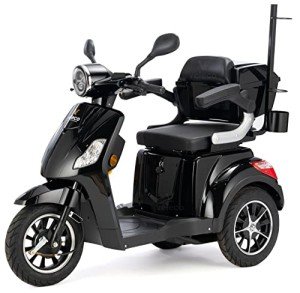15 Up-And-Coming Trends About Buying Mobility Scooter
A Comprehensive Guide to Buying a Mobility Scooter
Mobility scooters have actually become a vital tool for lots of individuals aiming to improve their self-reliance and mobility. With a vast selection of models and functions offered, picking the right mobility scooter can be intimidating. This short article offers a helpful guide to help consumers browse their alternatives, assess their needs, and make an informed purchase.
Understanding Mobility Scooters
Mobility scooters are electric automobiles created for people who experience mobility challenges. They are particularly beneficial for senior citizens, those with impairments, or people recuperating from injuries. Mobility scooters can vary commonly in regards to style, features, and rates.
Kinds Of Mobility Scooters
Before starting a purchase, it's essential to understand the different types of mobility scooters available:
Three-Wheel Scooters:
- Generally more maneuverable in tight areas
- Lightweight and portable
- Ideal for indoor usage
Four-Wheel Scooters:
- Offer higher stability and balance
- Appropriate for outdoor usage over numerous terrains
- Typically have a longer battery life
Foldable/Portable Scooters:
- Designed to be easily carried and stored
- Can often suit the trunk of a cars and truck
- Suitable for those who take a trip frequently
Sturdy Scooters:
- Built to accommodate larger individuals
- Often included more robust features for outdoor use
- Generally equipped with bigger batteries for prolonged range
Factors to Consider When Buying a Mobility Scooter
1. Weight Capacity
Choose a mobility scooter that can support the user's weight. The majority of scooters have a weight limit varying from 250 to 500 pounds. It is essential to ensure that the scooter can accommodate the user conveniently.
2. Range and Battery Life
The range is how far the mobility scooter can take a trip on a single charge. Typical varieties differ in between 10 to 30 miles. Think about the user's day-to-day activities and select a scooter with an ideal variety.
3. Scooter Dimensions
Think about the size of the scooter, including its weight and dimensions. A more compact scooter may be perfect for narrow hallways and tight areas, while larger models provide extra stability and comfort.
4. Surface Capability
Evaluate where the scooter will primarily be utilized. If scooters for mobility to travel primarily on pavement, a lightweight model may be enough. Nevertheless, if the user needs to pass through gravel or unequal surface areas, think about a four-wheel scooter developed for off-road use.
Leading Features to Look For
Convenience
- Adjustable Seats: Look for scooters with cushioned and height-adjustable seats to make sure comfort throughout travel.
- Armrests: These boost security and assistance while navigating.
Security and Visibility
- Headlights and Taillights: Essential for nighttime use.
- Turn Signals and Reflectors: Improve exposure and security while on the roadway.
User-Friendly Controls
- Joystick or Drive Controls: These ought to be instinctive and simple to manipulate.
- Easy-to-Read Displays: A control board that shows battery life, speed, and range can boost the user experience.
Additional Features
- Storage Compartments: These use added benefit for bring individual products while on the go.
- Weather condition Protection: Consider models with rain covers or windscreens if used in variable climate condition.
Expense Considerations
When budgeting for a mobility scooter, rates can range anywhere from ₤ 500 to over ₤ 5,000 depending upon the model, functions, and brand name. Extra expenses may include:
- Extended Warranty: Protects versus problems and can save cash in the long run.
- Devices: Optional features, such as upgraded seats, lights, or storage options.
Feature
Expense Range
Fundamental Models
₤ 500 – ₤ 1,500
Mid-Range Models
₤ 1,500 – ₤ 3,000
High-End Models
₤ 3,000 – ₤ 5,000
Funding Options
Many sellers use financing plans, and some regional federal government efforts may offer grants or support for those in requirement. Examine potential monetary support with neighborhood resources or mobility service companies.
Frequently asked questions about Buying a Mobility Scooter
What is the distinction between a mobility scooter and a wheelchair?
Mobility scooters are motorized and permit users to navigate independently, while wheelchairs might require physical assistance or manual operation.
How do I keep a mobility scooter?
Regular upkeep involves examining battery life, cleaning up the scooter, and inspecting tires and brakes. Constantly describe the user handbook for particular standards.
Can mobility scooters be used indoors?
Yes, numerous designs are designed for both indoor and outdoor usage. Nevertheless, three-wheel scooters tend to be much better suited for indoor navigation due to their tighter turning radius.
Are mobility scooters covered by insurance coverage?
Some insurance prepares cover a part of the costs for mobility scooters if they are deemed clinically essential. Contact your service provider for particular details.
How fast can a mobility scooter go?
Most mobility scooters have a maximum speed ranging from 4 to 8 miles per hour. However, the appropriate speed may differ depending upon regional policies.
Buying a mobility scooter can significantly boost one's self-reliance and lifestyle. By comprehending the types, features, and expenses connected with mobility scooters, prospective buyers can make educated choices that fit their needs and preferences. Personalization and thorough research are key to making sure complete satisfaction with this crucial investment.
